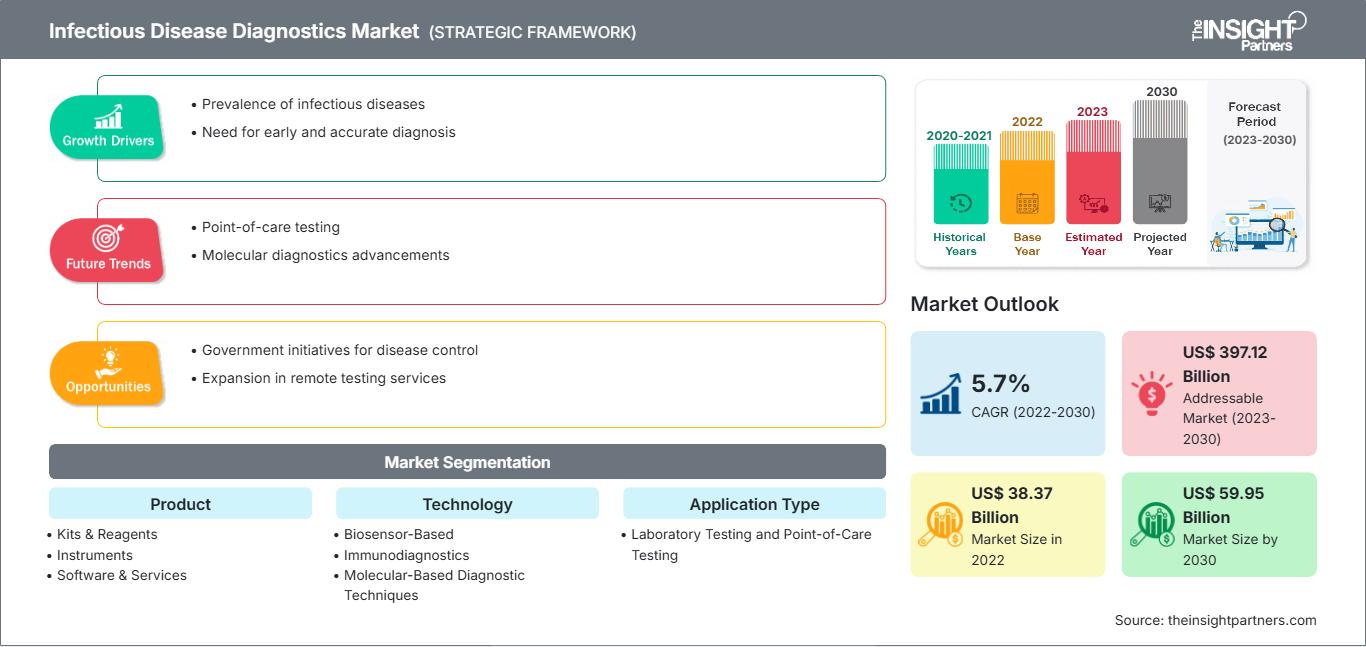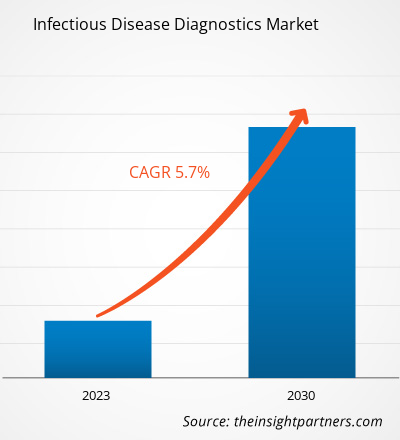[研究报告] 传染病诊断市场规模预计将从2022年的383.6638亿美元增长到2030年的599.5422亿美元,预计2022年至2030年的复合年增长率为5.7%。
市场洞察与分析师观点:
随着传染病病例的增加,以及技术先进产品的开发导致产品上市和产品审批的增加,传染病诊断市场规模正在不断扩大。2022年5月,BD公司在美国推出了其全自动、高通量传染病分子诊断平台——BD COR MX仪器。该仪器可自动化和集成完整的分子实验室工作流程,从样本处理到大型高通量实验室的诊断测试结果。 BD COR 系统省去了样本分类的工作,帮助实验室技术人员最大限度地减少与样本的接触,从而腾出时间进行其他关键的实验室流程。为了应对日益增长的传染病病例以及实验室能力和分子检测试剂的短缺,一些诊断检测制造商提供了快速易用的设备,以方便进行实验室外的检测。
增长动力与挑战:
兽医传染病对家畜、牲畜和野生动物的健康造成负面影响。由于集约化畜牧业,每年在室内饲养的数十亿头动物(通常健康状况较差)在基因和物理上相互接近,为疾病流行的出现和蔓延创造了条件。此外,由于农业用地扩张导致森林砍伐,畜牧业加剧了野生动物感染的传播。
能够及早发现新发传染病的诊断技术对于减少此类疾病爆发带来的经济损失至关重要。聚合酶链式反应 (PCR) 仍然是全球范围内检测动物病原体最广泛的分子检测方法。此类诊断方法操作简便、经济高效、灵敏度高、特异性强,并且能够进行大量检测。
自定义此报告以满足您的要求
您将免费获得任何报告的定制,包括本报告的部分内容,或国家级分析、Excel 数据包,以及为初创企业和大学提供超值优惠和折扣
传染病诊断市场: 战略洞察

-
获取本报告的主要市场趋势。这个免费样本将包括数据分析,从市场趋势到估计和预测。
尽管传统的病毒学方法非常可靠,但它们耗时耗力。侧流和酶联免疫吸附试验可用于快速检测。多重微珠免疫或Luminex检测是一种基于荧光微珠的高通量定量技术,用于在单次反应中同时检测针对不同传染病的多种特异性抗体,与传统的ELISA相比,可获得更快速、更经济、更准确的结果。此外,基于表面等离子体共振(SPR)的蛋白质芯片似乎是感染血清诊断或抗体滴度测定的快速有效工具。重组抗体也可以利用rDNA技术在异源系统中生产,并用于开发诊断测试。
即时诊断(POCD)是一种简单、快速、便携的诊断设备,可在现场检测疾病状态。近年来,实时PCR(qPCR)已转型为POCD平台。这些全自动平台结合了核酸提取、热循环和现场结果报告功能。例如,Enigma Diagnostics 公司的 MiniLab 是一个重达 10-35 公斤的分子诊断平台,可在现场携带,用于验证非洲猪瘟病毒、古典猪瘟病毒、禽流感病毒和口蹄疫病毒,以供研究之用。英国 Primerdesign Ltd 公司的 Genesig 检测试剂盒提供冻干 qPCR 检测试剂盒,可用于诊断 62 种牛病、42 种马病、47 种猪病、60 种禽病、40 种犬病和 26 种猫病原体,供研究之用。同样,博士德公司也提供 Bosterbio qPCR 试剂盒,可检测多达 48 个独立样本或混合样本。它用于基因表达谱分析、靶标 DNA 定量、微生物检测、病毒或细菌病原体负荷测定以及基于探针的 qPCR 引物对性能评估。
因此,PCR 和 qPCR 等诊断方法用于诊断动物的细菌、病毒、真菌和寄生虫感染,正在推动兽医诊断的发展。
大多数诊断测试的低报销率阻碍了制造公司开发新测试和开展大规模研究以支持广泛使用。此外,如果没有预期结果的数据来支持新测试的成本效益或证明现有测试,报销率仍然很低。
对新的或昂贵的诊断测试的报销困难和担忧可能会阻碍创新,并对诊断技术的广泛部署构成重大挑战。在美国,报销包括第三方付款人的承保、确定支付方式的医疗服务或疾病编码以及支付水平的确定。
对于使用现行程序术语 (CPT) 代码的门诊检测,医疗保险覆盖咨询委员会 (Medicare Coverage Advisory Committee) 建议医疗保险和医疗补助服务中心 (CMS) 就诊断检测覆盖范围做出建议,包括确定充分证据和健康福利。然而,大多数医疗保险报销决定是在地方层面而非国家层面做出的。诊断检测的覆盖范围因地区而异。此外,缺乏确定覆盖范围的标准可能会对新诊断产品的开发和可用性构成挑战。
在某些情况下,报销不包括检测费用,这限制了实验室提供检测,并降低了检测的可用性和使用率。在其他情况下,费用可能很高,但可能会给患者留下相当大的成本,从而限制医生定期安排检测。合规性和计费仍然是临床实验室面临的挑战,并限制了检测的可用性。因此,报销不足的情况阻碍了传染病诊断市场的增长。
报告细分和范围:
按产品划分,传染病诊断市场分为试剂盒和试剂、仪器以及软件和服务。按技术划分,传染病诊断市场分为基于生物传感器的诊断、免疫诊断、基于分子的诊断、临床生物学和其他。免疫诊断细分市场进一步细分为酶联免疫吸附试验、蛋白质印迹分析和免疫荧光测定。基于分子的诊断技术细分市场进一步细分为聚合酶链式反应、原位杂交、恒温核酸扩增技术、下一代测序、DNA微阵列和其他。按应用类型划分,传染病诊断市场分为即时检验和实验室检验。按检测类型,传染病诊断市场分为人体检测和兽医检测。人体检测市场进一步细分为艾滋病毒、肝炎、医院感染、人乳头瘤病毒、结核病、流感等。按最终用户,传染病诊断市场分为诊断实验室、医院和诊所、研究机构、家庭护理机构等。按地域划分,传染病诊断市场分为北美(美国、加拿大和墨西哥)、欧洲(英国、德国、法国、意大利、西班牙和欧洲其他地区)、亚太地区(中国、日本、印度、韩国、澳大利亚和亚太其他地区)、中东和非洲(阿联酋、沙特阿拉伯、南非和中东和非洲其他地区)以及南非和中美洲(巴西、阿根廷以及南美洲和中美洲其他地区)。
分部分析:
传染病诊断市场按产品分为试剂盒和试剂、仪器以及软件和服务。2022 年,试剂盒和试剂占据了最大的市场份额。然而,预计软件和服务市场的增速将在 2022 年至 2030 年期间最快。试剂盒和试剂市场的蓬勃发展得益于雅培 (Abbott)、罗氏制药 (F. Hoffmann-La Roche Ltd) 和伯乐 (Bio-Rad Laboratories, Inc.) 等众多制造商的加入。此外,为了应对医院获得性感染 (HAI)、流感和艾滋病毒 (HIV) 等传染病病例的增多以及实验室分子检测能力和试剂的短缺,多家诊断检测制造商已经开发并开始销售快速易用的设备,以方便在实验室环境之外进行检测。此外,试剂盒和试剂在各种研究过程中被广泛使用,产品发布也持续增长。例如,2021年7月,Cepheid宣布其Xpert HIV-1 Viral Load XC和Xpert HIV-1 Qual XC已获得CE-IVD认证,这两款产品是用于HIV检测的下一代扩展覆盖(XC)检测产品。Xpert HIV-1 Viral Load XC为HIV-1检测提供了第二个靶点,其扩展了病毒株覆盖范围,从而提高了检测性能,并降低了因基因突变或缺失导致假阴性结果的风险。因此,由于市场参与者纷纷提供多种试剂和试剂盒,以及技术进步的推动,预计该细分市场在预测期内将实现增长。
受技术进步以及新软件的采用等因素的影响,预计软件和服务细分市场在未来几年将实现增长,以减轻传染病负担。许多公司正在推出软件来分析传染病发病率的上升趋势,预测随时间推移的趋势和疫情爆发情况,并评估遏制措施的有效性。因此,已经建立了几个统计模型,主要基于易感-暴露-感染-康复或移除 (SEIR) 模型。此外,受科学界多学科协作的启发,疾病建模研究所 (IDM) 一直在构建建模工具,这些工具是研究和软件团队成员广泛合作的成果。这些工具提供了定量和分析方法,可以通过模型来表示传染病的传播。IDM 软件工具免费公开与科学界共享,以便借助计算建模加快疾病根除工作。因此,预计主要参与者采取的此类举措也将在未来几年推动该领域的增长。
区域分析:
根据地域划分,传染病诊断市场细分为北美、欧洲、亚太地区、中东和非洲以及南美洲和中美洲。北美是全球传染病诊断市场增长的最大贡献者。预计亚太地区将在2022年至2030年期间实现传染病诊断市场的最高复合年增长率。美国传染病诊断市场的增长主要受传染病患病率上升、老年人口增加以及主要参与者推出的产品数量增加的驱动。老龄化是传染病的一个主要危险因素,因为60岁以上的人通常免疫力较低。根据美国人口参考局2020年发布的一项研究,2020年美国65岁及以上人口为5500万,预计到2060年这一数字将达到9500万。美国监管机构正在实施优惠政策,以开发用于诊断和治疗各种适应症的即时诊断(POC)产品。 2021年3月,美国食品药品监督管理局 (FDA) 批准Binx Health IO CT/NG检测试剂盒可用于社区诊所、紧急护理机构和门诊医疗机构;这是首个用于诊断衣原体和淋病感染的POC检测产品。2022年5月,全球领先的医疗技术公司之一——碧迪公司 (BD) 宣布,其全新的全自动高通量传染病分子诊断平台将在美国市场上市。全新BD COR MX仪器作为BD COR平台的分析仪器选件推出,并已获得FDA的510(k)许可。BD CTGCTV2分子检测试剂盒是新系统上首个可用的检测试剂盒,它能够一次性检测三种最常见的非病毒性性传播感染 (STI)——淋病奈瑟菌 (GC)、沙眼衣原体 (CT) 和阴道毛滴虫 (TV)。
传染病诊断市场区域洞察
The Insight Partners 的分析师已详尽阐述了预测期内影响传染病诊断市场的区域趋势和因素。本节还讨论了北美、欧洲、亚太地区、中东和非洲以及南美和中美洲的传染病诊断市场细分和地域分布。
传染病诊断市场报告范围
| 报告属性 | 细节 |
|---|---|
| 市场规模 2022 | US$ 38.37 Billion |
| 市场规模 2030 | US$ 59.95 Billion |
| 全球复合年增长率 (2022 - 2030) | 5.7% |
| 历史数据 | 2020-2021 |
| 预测期 | 2023-2030 |
| 涵盖的领域 |
By 产品
|
| 覆盖地区和国家 |
北美
|
| 市场领导者和主要公司简介 |
|
传染病诊断市场参与者密度:了解其对业务动态的影响
传染病诊断市场正在快速增长,这得益于终端用户需求的不断增长,而这些需求的驱动因素包括消费者偏好的演变、技术进步以及对产品优势的认知度的提升。随着需求的增长,企业正在扩展产品线,不断创新以满足消费者需求,并抓住新兴趋势,从而进一步推动市场增长。

- 获取 传染病诊断市场 主要参与者概述
行业发展和未来机遇:
传染病诊断市场主要参与者采取的各种举措如下:
- 2023 年 1 月,Trinity Biotech 宣布与 imaware Inc 建立战略合作伙伴关系,将他们为合作伙伴打造的数字健康平台与 Trinity Biotech 先进的参考实验室设施相结合,为数字健康行业提供家庭和远程测试计划。
- 2022 年 11 月,Bio-Rad Laboratories Inc 扩展了其独立质量控制产品组合,包括 InteliQ 和 Liquichek 紧凑型小瓶。这些产品将用于雅培的 Alinity CI 系列,该系列集成了临床化学和免疫分析检测仪器。
- 2021 年 12 月,罗氏公司 (F. Hoffmann-La Roche Ltd) 在接受 CE 标志的国家/地区推出了首批基于新型分子实验室仪器 cobas 5800 系统的传染病检测产品。这些产品包括 cobas HIV-1、cobas HBV、cobas HCV、cobas HIV-1/HIV-2 定性检测以及 cobas omni Utility Channel 试剂盒。这些产品的发布扩展了罗氏分子诊断产品组合,为低、中、高容量的分子实验室检测需求提供标准化的性能和效率。
竞争格局和主要公司:
雅培实验室、布鲁克公司、康德乐公司、罗氏公司、Trinity Biotech Plc、丹纳赫公司、Bio-Rad Laboratories Inc、AccuBioTech Co Ltd、ACON Laboratories 和 DiaSorin SpA 是传染病诊断市场的领军企业。这些公司专注于新产品的发布和地域扩张,以满足全球日益增长的消费者需求,并扩大其专业产品组合的范围。他们的全球影响力使他们能够服务于庞大的客户群,从而促进市场扩张。
- 历史分析(2 年)、基准年、预测(7 年)及复合年增长率
- PEST和SWOT分析
- 市场规模、价值/数量 - 全球、区域、国家
- 行业和竞争格局
- Excel 数据集
近期报告
客户评价
购买理由
- 明智的决策
- 了解市场动态
- 竞争分析
- 客户洞察
- 市场预测
- 风险规避
- 战略规划
- 投资论证
- 识别新兴市场
- 优化营销策略
- 提升运营效率
- 顺应监管趋势






















 获取免费样品 - 传染病诊断市场
获取免费样品 - 传染病诊断市场